The flute is played, the drums beat, and the worshippers quietly step into the shrine and take their seats on the set up hou bed (cloth covered stool). The clergy wave the ritual props and read the benediction, and the worshippers on the stage wrap their arms around their children and bow their heads in prayer.
This seems to be an ordinary "7-5-3 festival visit". Japanese people bring their children to the shrine on November 15 in the years when they are three, five and seven years old to express their gratitude to the gods and to pray for the healthy growth of their children. As the poet monk Ryokan wrote more than two hundred years ago.
May the little pine tree of blessing / Add full happiness to boys and girls aged three, five and seven.
The only difference: the worshippers brought, not real children, but Sony Aibo robotic dogs.
The robot dog, which was launched in January 2018, will turn 3 years old in 2021. So on November 15 of that year, Tokyo Kanda Shrine held the "Aibo Robot Dog's 7-5-3 Festival", inviting the "parents" who treat the robot dog like their own to come and pray for a purification ceremony.
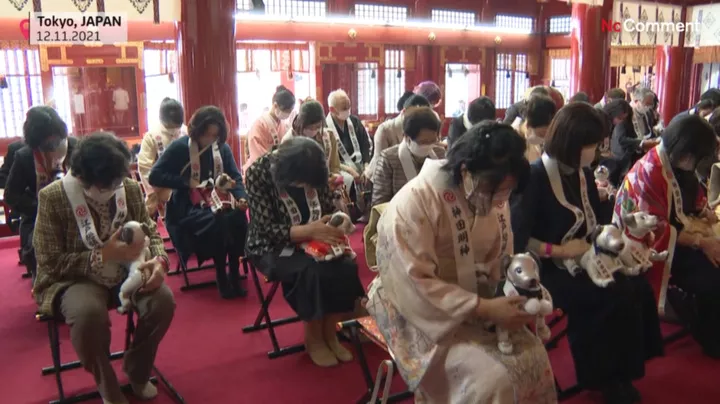
▲ Worshippers with their heads bowed in prayer. Photo from: EuroNews
Not coincidentally, it was in 2018 that Koufukuji Temple in Eisumi City, Chiba Prefecture, Japan, held one of the largest offering puja for the first generation of Aibo robotic dogs, with 800 soon-to-be-disassembled robotic dogs wearing tags with their owners' names and hometowns on them, at The 800 soon-to-be-disassembled robotic dogs with tags bearing their owners' names and hometowns received "superlatives" from monks at the puja.

▲ Between 2015 and 2018, Koufukuji Temple performed 4 pujas, this is the site of the pujas in 2016. Image from: nippon.com
Behind this story of death and rebirth is a 20-year obsession with robot dogs.
Create a robot dog
In 1993, Professor Hiroaki Kitano, currently President and CEO of Sony Computer Science Laboratories, joined Sony. His first assignment was to design a robot in a five-year cycle.
Given the state of the art at the time, his team agreed that they couldn't create a robot that could do a specific job, so they decided to go the other way and make a robot for entertainment that could talk to people and make them happy.
The team brought in a famous designer to assist with the design, and the latter gave a sketch of a proposal in which the robot looked so much like a puppy that they quickly accepted the setup and decided to make a robot dog out of it.
On May 11, 1999, the Aibo robot dog was born. At a time when artificial intelligence was still very new to people, Aibo (Artificial Intelligence Robot) brought the concept of 'artificial intelligence' to the masses, which could respond to human commands with the help of cameras and microphones.
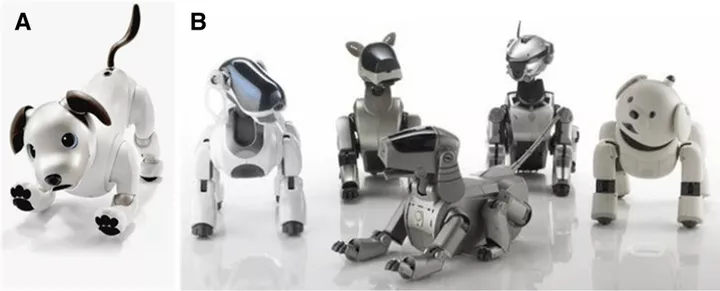
▲ First generation Aibo ERS-110 model in the forefront Image from: Sony-Aibo.com
It is also pronounced like the Japanese word "aibō" (meaning partner, companion), signifying its groundbreaking companionship function. With its advanced concept and sci-fi appearance, the first 3,000 Aibo robotic dogs sold out in just 20 minutes, despite the high price of 250,000 yen.
At the time, Sony wasn't bold enough to define the far-from-perfect Aibo as a 'robot dog', but simply said it was an 'entertainment robot' so that people wouldn't misunderstand it as a replacement for a real dog. But in fact, many buyers did treat it like a real puppy, quickly accepting it as part of the family, and even when it broke down and went in for repair, dog owners said "it's a bit uncomfortable in the joints" rather than "it's broken".
Although the Aibo sold a total of 150,000 units before it was discontinued in 2006 and was well received by the market, the group entered the 21st century in poor business conditions and Sony executives eventually called a halt to the Aibo project in order to cut costs, to the detriment of users.
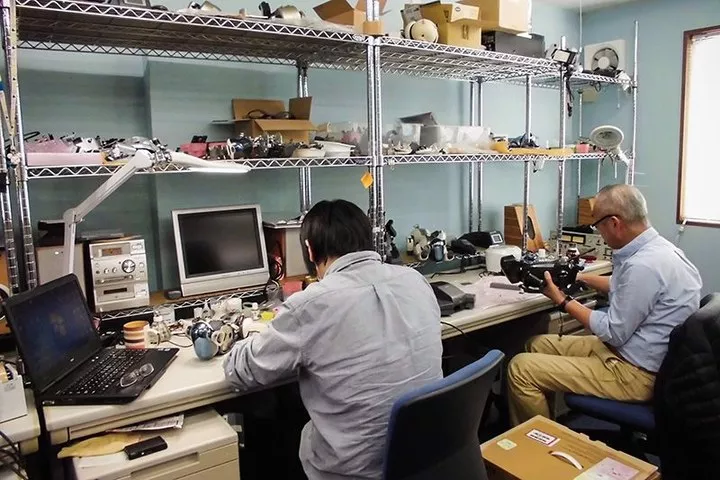
▲ A-Fun staff working on the Aibo. Photo from: A-Fun
The Aibo robotic dogs that have been brought into people's homes are continuing their mission.
Fortunately, Aibo was a very 'long-lived' piece of tech overall, but it was inevitable that the surviving robotic dogs would wear out and fail over time. Unfortunately, Sony ended its final aftermarket repair support in 2014 as planned.
Even though there is a subsequent A-FUN ~Craftsman Workshop~ founded by former Sony employees dedicated to repairing these out-of-warranty Sony electronics, the fact that parts are no longer being manufactured means that they must dismantle discarded Aibo's to get parts to repair other robotic dogs.
This is what led to the large "sacrificial ritual" at the beginning of the text.
The rebirth of Aibo
As Sony's business conditions began to improve in the 2010s, the group decided to return to AI and robotics. When asked what project should be started first, Hiroaki Kitano, the creator of Aibo, replied, "Let's bring Aibo back.
During the time that the Aibo project was on the chopping block, Hiroaki Kitano witnessed the loss and loneliness of its users and decided that the first order of business was to bring Aibo back.
On January 11, 2018, the second generation of the Aibo robot dog was officially released - just in time for the Year of the Dog. The date was chosen because January 11 is pronounced "wan-wan-wan" in Japanese English, which is similar to the sound of a dog's bark.
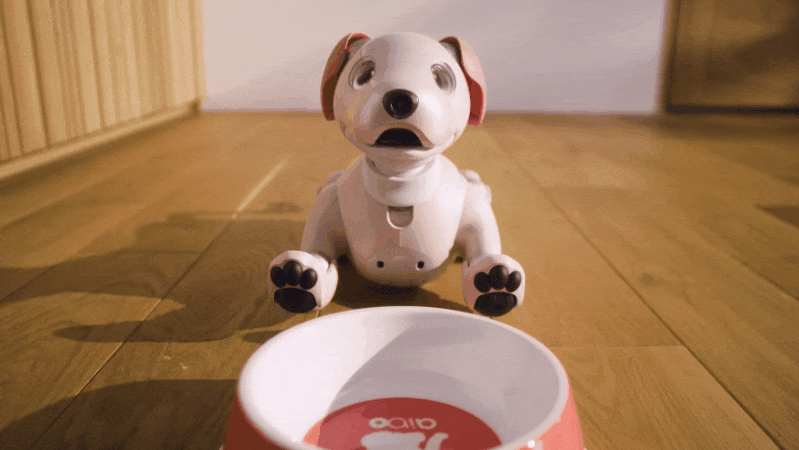
This time, instead of using the 'entertaining robot' hide word, Sony confidently declares that it is the robot puppy.
The Daft Punk-style "electronic helmet" of the first generation Aibo has also been replaced with droopy ears and large eyes that more closely resemble those of a golden retriever. The eyes, made up of LED screens, can now express more emotion.
More than 4000 parts and 22 movable joints also allow Aibo to more realistically mimic the behavioural movements of a puppy.
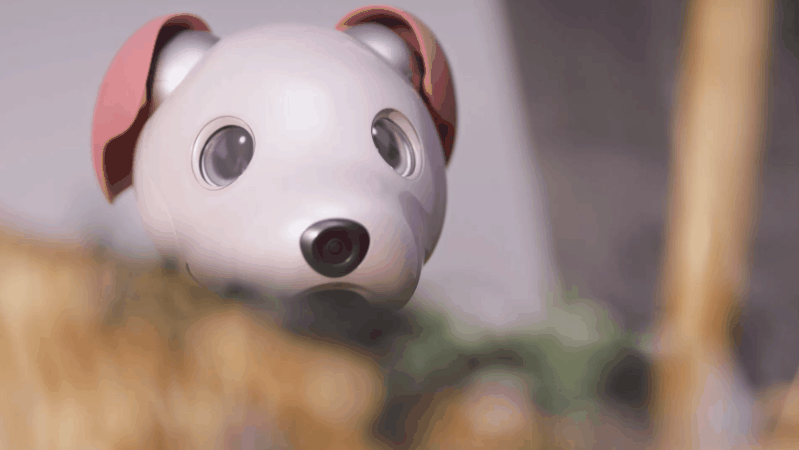
At the launch commemoration of the new generation of Aibo, Yasuyuki Nakamura, a 46-year-old Osaka office worker, said.
I've been waiting for the return of Aibo, I'm here (in Tokyo) today on the bullet train, and I'm going to name my Aibo Light (Hikari).
Aibo has been reborn after 12 years, and it's not just gotten cuter, it's gotten a lot smarter than its predecessor thanks to the rapid advances in computing power and AI technology in that time.

The new version of Aibo can understand commands such as lie down, shake hands, give high fives, sing, dance, roll around and even play dead, and sensors all over its body allow it to accurately sense its owner's touch.
For example, it will use the camera to map the home, learn to find the charger on its own, as well as take the initiative to find the owner to play with when it finds the owner is not around. In addition, it will rely on facial recognition to slowly become familiar with the owner's family members and use data collection to understand the owner's emotional preferences so that it can adjust its behavior to make itself more pleasing to the family.
Users now don't have to worry that the new generation of robot dogs will "die" due to the aging of parts and failures, just like the first generation of Aibo. It will be connected to the Internet, saving data such as owner's preferences and personality development to the cloud, which can be inherited to other robotic dogs later, so that your beloved pet can live forever.
Of course, according to the law of equivalence, a small price to pay for eternal life is the 217,000 yen price of the body, a 3-year 99,000 yen subscription to the cloud service and a 59,400 yen warranty service fee (about 19,000 RMB in total).
I'm afraid it's quite a bit more expensive than breeding real puppies when you really do the math.
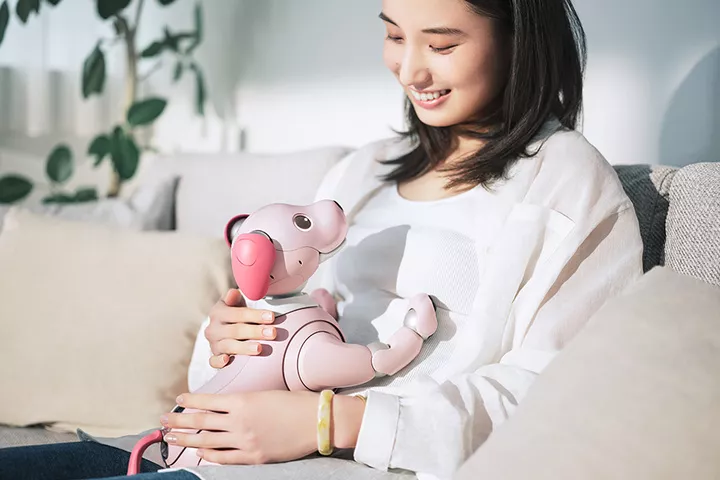
However, robot dogs do have some advantages that real animals can't match.
In Zhao Haihong's short science fiction novel "Baby Baby I Love You," the protagonist designs a "holographic baby" that brings the joy of raising a child, but avoids all the troublesome aspects of real parenting.
Aibo robotic dogs are just such creations: they may seek out their owners to pamper them or bark in the middle of the night, but as soon as their owners command them to be quiet, the robotic dogs will immediately behave. Dog owners also don't have to worry about feeding, walking, getting sick and collecting excrement, meaning that even working people who live in small, non-soundproof apartments and don't have a lot of time can rely on Aibo to perfectly fulfill their desire to have a pet.
Of course, if that's not real enough, Sony also offers a food bowl and water bowl AR accessory that lets people earn badges by feeding the bionic dog electronic food.
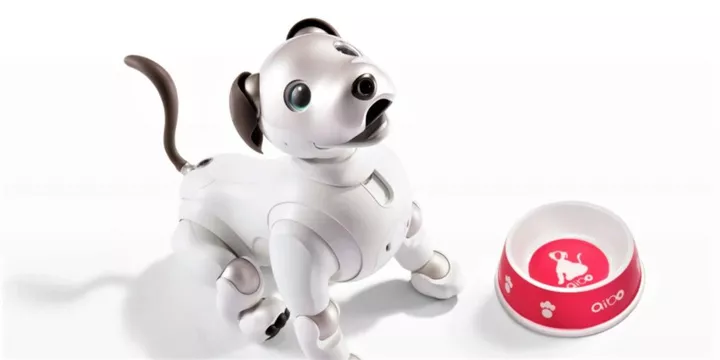
▲ Virtual Feeding Kit for 2178 yen (about $110). Image from: Scree Rent
The robot dog also doesn't have the stress response of an animal, and dog owners can take Aibo to cafes and socialize with other robot dogs in a big way.
They bring a mischievous joy by making a mess, circling each other, and listening to the wrong commands like real puppies; but at the same time, they can learn skills from each other or dance and perform as a team, a sight you don't see in real pet socialization.
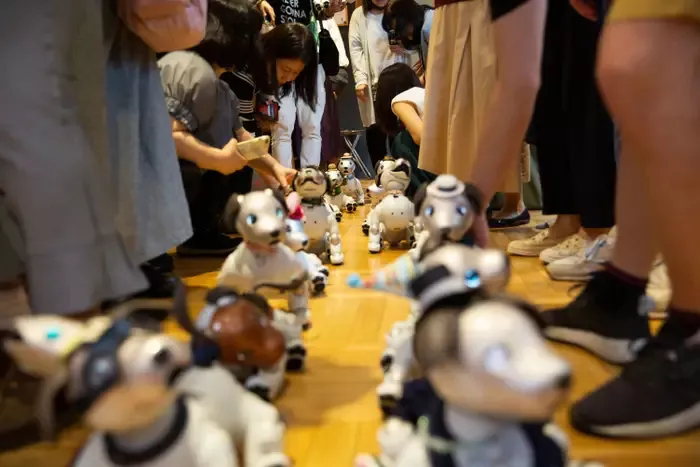
▲ The Aibo's who were brought to the social event. Photo by: Taro Karibe for Buzzfeed News
You may be wondering: why does it have to be a robot dog and not a robot cat?
In an interview with Geek Park, Hiroaki Kitano, a veteran "cat slave", replied that dogs love to interact with people, while cats are often indifferent. If it was really made into a robot cat, Sony's after-sales hotline would probably be overwhelmed, and users would probably complain, "This cat is ignoring me! And the customer service staff can only reply "cats are like this ......"
Besides, we, who are heavily indoctrinated by Fujiko F. Fujio, would probably prefer Robocat to have a Hyakubo bag instead of just being a meek kitty who lets people jerk him around.
The antidote to the age of loneliness
Just because Hiroaki Kitano says so doesn't mean that no one has ever tried to make a robot cat.
Back in 2015, toy giant Hasbro launched a smart plush cat toy called Joy for All for companionship with the elderly. It purrs when stroked and opens its eyes to pout if someone gets in the way of the light sensor.
Similarly, Paro, a smart plush seal invented at the same time as Aibo, has been widely used in a clinical study showing that interaction with Paro can improve symptoms of depression, anxiety and pain, and is now being used to relieve stress in children in the ICU, treat veterans with PTSD and dementia patients.
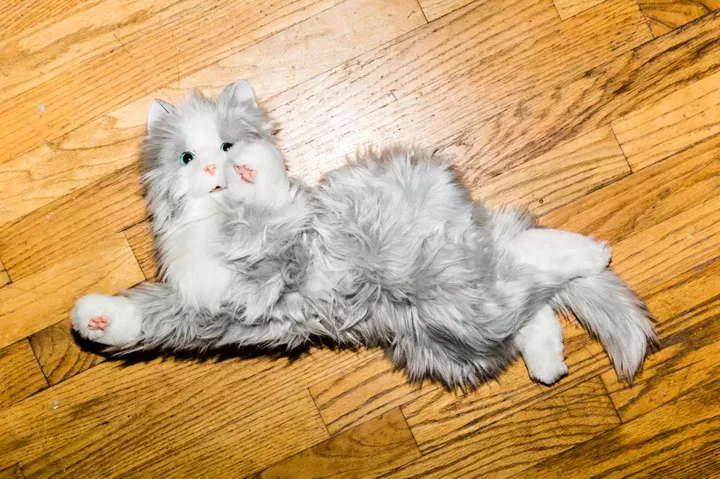
Hasbro's Joy for All plush doll. Photo courtesy of Cole Saladino for Thrillist
However, these plush toys are relatively limited in their intelligence, and at best provide limited comfort, rather than being consistently nurtured like a real pet.
In this regard, it is clear that there is still a lot of potential for AI technology to be explored. When it comes to the purpose of developing Aibo, Sony has said that they want to make the relationship between users and AI not a cold "user and tool", but to explore the emotional interaction between humans and AI, so that the latter can grow into a friend to accompany the user.
The same concept can be found on Lovot (Love+Robot), developed by Groove X.
It looks like a little penguin, is programmed to have a body temperature of 37°C, raises its head to gaze at people when they speak, and has a built-in emotion program to develop good and bad feelings towards people: if someone regularly ignores or even abuses Lovot, the robot will choose to avoid them; conversely, if it is loving, it will receive warmth from the robot.
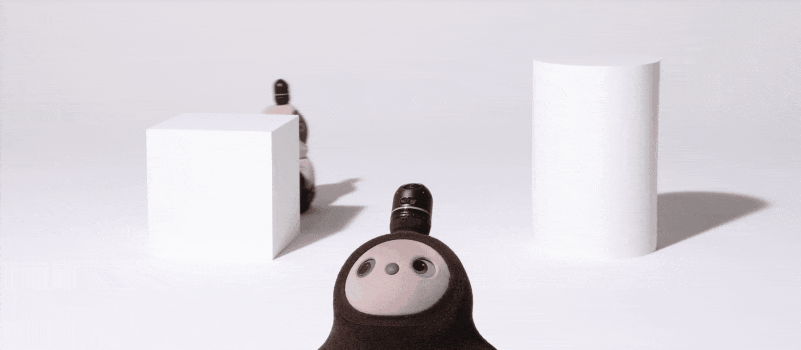
▲ The cute Lovot robot. Image from: Lovot official website
Whether it's a stuffed animal or a more refined AI robot, the value of the companionship they bring in a world that is becoming increasingly alienated by the new crown epidemic and the growth of ageing and urbanisation cannot be underestimated.
According to estimates from Japan's Yano Institute of Economic Research, the domestic market for 'communication robots' such as Aibo has swelled rapidly from about 850 million yen in 2014 to 8.7 billion yen by 2020. In the face of widespread loneliness brought on by busy modern life and changing family structures, it is clear that ever-evolving iterations of artificial intelligence robots are bringing new solutions to complex social problems in a warm and soft way.

For example, in 2019 Sony updated a feature for Aibo called 'Aibo Patrol', where the owner can ask the Aibo robot dog to remember the face of the person they are looking for beforehand, and then it will regularly play the tune of 'Puppy Patrol' every day to patrol all over the house to find that person and show him some cute moves; Sony also announced a partnership with home security service SECOM, which in the future may bring security features such as monitoring the well-being of family members and preventing house burglaries.
In the future, when we lack the companionship of our loved ones, it will probably be a variety of robots that will accompany us.
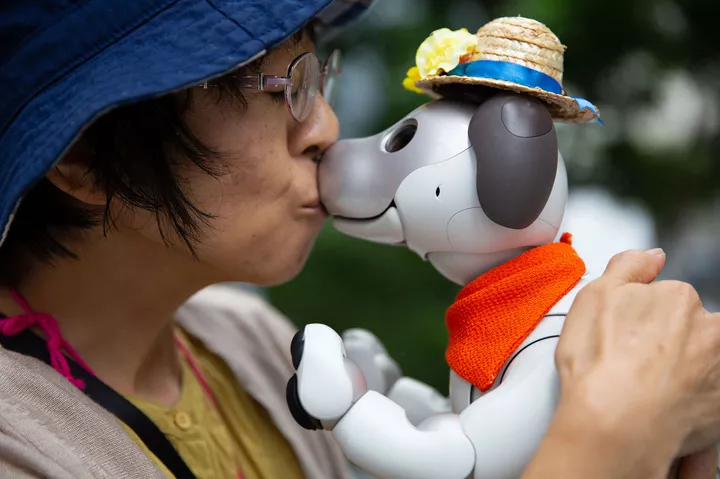
▲ An elderly man kisses her robot dog. Image via Taro Karibe for BuzzFeed News
In 2019, a reporter for digital media outlet BuzzFeed visited some of Aibo's owners at cafes and events in Tokyo, many of whom were older people with graying hair. They often dress up their robotic dog, dressing it up in sun hats, necklaces and flower accessories, and opening social media accounts for it to record memories of family outings. In an interview, one dog owner had this to say.
I never thought of him as a toy, to me he was my family.